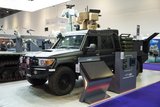General Dynamics unveils rugged smart displays
General Dynamics Canada has unveiled its new ultra-rugged SD8000 family of smart display products with the quad-core 3rd generation Intel Core processor, bringing latest in commercial computing to military vehicles. These new smart displays meet the computing-intense requirements of the battlefield while conserving size, weight and power inside military vehicles, effectively doubling the computing capabilities of previous dual-core smart displays.
Developed for ground combat vehicles in harsh military environments, these enhanced product features provide a flexible platform that adapts to the changing dynamics of missions while supporting interoperability and future technology enhancements. General Dynamics' rugged Smart Displays are onboard a variety US Army ground combat vehicle platforms including the Mine Resistant Ambush Protected (MRAP), Stryker and Bradley vehicles. With a significant savings in weight, space and power over conventional architectures, General Dynamics' smart displays provide increased affordability and easy integration into vehicle C4I sub-systems.
According to the company, the next generation displays are naturally convection-cooled to meet rigorous military standards. Additional key features include touch screen, multiple video and audio input channels, streaming and snapshot video capture, multiple vehicle-bus interfaces, wireless communications, VoIP capabilities, embedded Ground-Based GPS Receiver Application Module (GB-GRAM), multiple I/O ports and a solid state hard drive. General Dynamics has also integrated Intel Virtualization Technology to enable the use of Multiple Independent Levels of Security/Safety (MILS), a high assurance security architecture for controlled information.
More from Digital Battlespace
-
![Babcock nears first customer for Nomad AI translation tool]()
Babcock nears first customer for Nomad AI translation tool
Nomad can provide militaries with real-time intelligence, saving critical time on the battlefield.
-
![AUSA 2025: Israel’s Asio Technologies to supply hundreds of improved Taurus tactical systems]()
AUSA 2025: Israel’s Asio Technologies to supply hundreds of improved Taurus tactical systems
Taurus operates alongside the Israel Defense Forces’ Orion system which supports mission management across tens of thousands of manoeuvring forces, from squad leaders to battalion commanders.
-
![AUSA 2025: Kopin pushes micro-LED plans as China moves faster]()
AUSA 2025: Kopin pushes micro-LED plans as China moves faster
The plan for the new displays follows fresh investment in Kopin’s European facilities by Theon and an order for head-up displays in fielded aircraft, with funding from the US Department of Defense.
-
![AUSA 2025: Persistent Systems to complete its largest order by year’s end]()
AUSA 2025: Persistent Systems to complete its largest order by year’s end
Persistent Systems received its largest ever single order for its MPU5 devices and other systems earlier this month and has already delivered the 50 units to the US Army’s 4th Infantry Division.
-
![Aselsan brings in dozens of companies and systems under the Steel Dome umbrella]()
Aselsan brings in dozens of companies and systems under the Steel Dome umbrella
Turkey has joined the family of countries attempting to establish a multilayered air defence system with government approval in August 2024 for the effort landed by Aselsan. Dubbed Steel Dome, the programme joins Israel’s Iron Dome, the US Golden Dome, India’s Mission Sudarshan Chakra and South Korea’s low-altitude missile defence system.
-
![DSEI 2025: MARSS unveils new agnostic multidomain C4 system]()
DSEI 2025: MARSS unveils new agnostic multidomain C4 system
MARSS’ NiDAR system has been deployed using sensors from static platforms to provide detection and protection for static sights, such as critical infrastructure, ports and military bases.




























